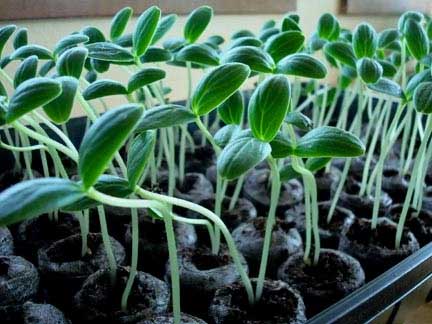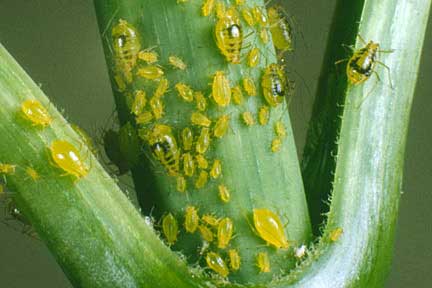Cucumber Gardening Made Easy
One of the easiest and most rewarding ways to grow cucumbers is in a raised bed system. Not just any old system but a cinder block garden. This garden system requires no hammer, nails or wood. It uses cinder blocks for the walls. Inside the blocks you can tailor your soil mix to suit your personal needs and worry less about the limitations of your local soil conditions. It’s even attractive enough to replace those sterile plots of plant life we call “lawns” and sidewalk green space. Raised bed containers can use as little as ¼ the space of a conventional row garden and need up to 1/4 the time and water to grow the same amount of food.
Six cucumber hills will provide all the cucumbers a family of five people could want, assuming three are destined for pickle making and the other three are for fresh eating and cooking. If there are only one or two people at your house, two cucumber mounds is still a prudent bet. If one of your plants dies or under-produces you only have one you are out of luck. If not, you have some extras to share with friends, family and neighbors.
A 40 inch by 40 inch bed can yield approximately 32 pounds of cucumber. A trellis is highly recommended as it saves garden space and keeps the vines drier and that in turn prevents most diseases.
Getting Started, House Cucumbers
Cucumbers are really easy to start in the house. If you want a jump on the growing season, you can start your cucumbers in the house. The plants grow really fast so start your cucumbers no more than 3 weeks before your last frost date. To start your seeds you will need some sterile potting soil and some biodegradable pots. “Peat Pots” found in almost any garden or nursery store excel at this function. A frugal alternative is newspaper pots.
 Cucumbers are picky about having their roots disturbed. The cucumbers like a four inch pot. Plant 4 seeds per pot and leave the plants together. When you plant the cucumbers outside, plant the pot and all and leave the 4 plants together, this is called a hill. Grow your cucumbers in a sunny window until it is time to plant them out. Once the plants have four leaves, it is time to start feeding them with half strength liquid fertilizer or some compost tea.
Cucumbers are picky about having their roots disturbed. The cucumbers like a four inch pot. Plant 4 seeds per pot and leave the plants together. When you plant the cucumbers outside, plant the pot and all and leave the 4 plants together, this is called a hill. Grow your cucumbers in a sunny window until it is time to plant them out. Once the plants have four leaves, it is time to start feeding them with half strength liquid fertilizer or some compost tea.
Before you plant your cucumbers outside, harden them off. What does this mean? The plants like people who have been in the house are sensitive to the sun and can sun or wind burn easily. Expose your cucumbers to the sun a little at time to get them use to being outside. It will take 4 to 7 days to get your plants ready to live outdoors permanently. Start hardening the plants a week before it is time to plant them out. Hardening off also applies to the plants that you pick up at the local nursery if they have been in a greenhouse. Below is an ideal hardening off schedule. Follow it the best you can or modify it to fit your needs.
Day 1: Set the plants out in an area that is free of wind, warm above 60F and will only get a few hours of sun. The plants can stay out as long as it is warm, wind free and little sun. Be sure to check the soil moisture frequently, the plants have a tendency to dry out fast when they are set outside.
Day 2: Set the plants out for 3 hours in the sun and a slight breeze, be sure that the temperature is warm. Check soil moisture.
Day 3: Set the plants out in the sun for 4 hours in a breeze, and still in the warmth of the day. Check soil moisture.
Day 4: Set the plants out for 5 hours in the sun and breeze, but not windy. Set them out earlier in the day to get some cool air. Check soil moisture.
Day 5: Leave the plants out all day in the breeze and in the sun. Be sure to check the soil moisture. The plants may need to be watered more than once on a warm day. I put my plants in a shallow dish of water and let them wick up all the water they want.
Day 6: Leave the plants out all day and all night if it is above freezing. They should be fairly tough by now. Check soil moisture.
Day 7: Plant the plants in the garden. If a frost is predicted during the next 7 days, cover your plants. Water well.
Garden Start
If you start your cucumbers in the garden, plant 4 seeds in one spot called a hill. Water well and keep moist until the seedlings emerge. Once the seeds are up, they will not need wind or sun protection but a frost will kill them. Black plastic on the ground can help to warm the soil and help the cucumbers to grow faster.
What Kind of Cucumbers Should I Plant?
Cucumbers growers won’t suffer for lack of variety; there are many shapes and sizes to choose from. Let’s explore the different types. There are hybrid cucumber seeds (seeds that are cross bred to enhance a feature) and there are non-hybrid seeds or “Heritage” seeds (the kind traditionally grown every year, saving the seeds from each harvest). The later is growing in popularity because it allows growers to save their own seeds and eliminate the cost of buying new seeds every year. In some areas, hybrids can be useful in resisting weather, disease and pest cucumbers can’t normally cope with.
Burpless These cucumbers have less “burp” in them. They are milder on your stomach, if you have trouble eating regular cucumbers because they make you burp then the burpless variety might be for you.
Armenian (65 days) Armenian is the mildest of all cucumbers. It is actually in the squash family, but taste like a cucumber. These cucumbers can get up to 3 feet long. They are light green and ribbed. Harvest can start when the cucumber is 10 inches long. They like really warm weather and will not do anything until the weather warms up. They like to grow on a trellis. These are great cucumbers and once you try them, you will want to grow them every year. This cucumber is a non-hybrid and you can save the seeds to grow a new crop.
Muncher (65 days) This is a great burpless cucumber. It is a heavy producer. Pick the cucumbers small for the best flavor. This is also a non-hybrid and you can save the seeds off of it to grow a new crop. Other burpless cucumbers that are hybrid but are not reliable for seed saving are: Tasty Green Hybrid, Tasty King Hybrid, Sweet Slice Hybrid, Burpless Orient Express
European Cucumbers
European Cucumbers are typically grown inside a greenhouse. Sometimes you can find them in the supermarket in shrink wrapped plastic. They taste great and require no peeling. The seeds are extremely expensive but they will grow outdoors if you really want to grow them.
Hybrids varieties include: Aria, Tyria, and Sweet Alphee.
Funny Cucumbers
It is sometimes fun to grow a novelty cucumber. Lemon (64 days) cucumbers are right at the top of the list. These are 3 inch round yellow cucumbers. They look like lemons but taste like cucumbers. They are a fun novelty and look great in salads, they taste good too! If you want a square cucumber, place a small cucumber (while it still hangs on the vine) in a square container and let it grow to the shape of the container. If the container had a face on the inside, the cucumber would mold to the shape of the face.
Problems
Once in a while you will run into a problem with your cucumber plants. Many growers are inclined to pull up the plants if they show advanced signs of diseases or are heavily infested with pests. If they are not to bad, however, you may want to try to save the plants. Here are some hints.
Pests of Disease?
Cucumber beetles can attack your cucumber plant. This beetle can carry a bacteria wilt. This wilt can take down a cucumber plant really fast. It will wilt and die. There is no cure so pulling up the plant a throw it away or burning it, may be your only option, especially when attempting to prevent spread to your other cucumber plants.
 Aphids are soft, pear-shaped bodied insects that suck the juice out of your plants. Some aphids have wings. Most aphids are green but they also come in red, yellow, gray and black. Aphids are about 1/8 inch long, have 6 legs and are born pregnant (seriously). Female aphids can give live birth to pregnant females, occurring for several generations. In the fall, the female aphids mate with a male to produce eggs that winter over.
Aphids are soft, pear-shaped bodied insects that suck the juice out of your plants. Some aphids have wings. Most aphids are green but they also come in red, yellow, gray and black. Aphids are about 1/8 inch long, have 6 legs and are born pregnant (seriously). Female aphids can give live birth to pregnant females, occurring for several generations. In the fall, the female aphids mate with a male to produce eggs that winter over.
Aphids secrete a sticky honeydew substance from their rear. Ants will carry the aphids around and harvest the honeydew from the aphids. In the fall ants will carry aphid eggs into their nest and take care of the eggs until spring. In the spring the ants will return the aphid eggs to the plants. If you have an ant invasion, look for aphids as well. To eliminate aphids there are several methods:
- Wash the aphids off the plants with a strong spray of water.
- Tobacco spray: Soak tobacco leaves in water for 24 hours. Dilute solution until it looks like weak tea. Then spray on plants. Be sure to hit the bug with the spray. Aphids tend to hide on the underside of leaves and on the main stems.
- Rhubarb spray: Boil one pound of rhubarb leaves in 1 quart of water. Next take two cups of water and mix in one tablespoon of dish soap. When the rhubarb has cooled pour off the liquid and add it to the soapy water. Spray on aphids.
- Safer Soap™: Safer Soap™ is a product you can purchase at most local nurseries. It works well on aphids if you can get it on the body. It kills by suffocation. Aphids breathe through their pores. Safer Soap™ clogs their pores and they can’t breathe.
- Neem oil: Neem oil is a byproduct of the Neem tree seed. It is considered a natural way of killing aphids. Local nurseries will often carry Neem oil.
- Diatomaceous earth: Diatomaceous earth is ground up fossilized sea shells. Diatomaceous earth will puncture soft bodied insects and they will dehydrate and die. Local nurseries should carry diatomaceous earth.
- Home-made soft bodied bug spray: Mix three tablespoons of dish soap and one gallon of water. Spray on the aphids every other day for two weeks. Test plants first to see if the soap will burn the leaves.
- Non-fat for aphids: To control aphids apply non-fat dried milk, mixed according to the instructions on box. Spray the leaves of your plants with the milk. The aphids get stuck in the milky residue and perish.
- Repellant spray: This can be used to repel aphids and whiteflies, slugs and cut worms. Reapply after rains or once a week. Mix one minced bulb of garlic, one small minced onion, one tablespoon cayenne pepper, one quart water. Let steep for three hours. Next add one tablespoon liquid soap. Strain and put in sprayer. Spray on plants.
- Garlic oil spray: Use for control over aphids, cabbage loopers, earwigs, June bugs, leafhoppers, squash bugs, and whiteflies. Mince one bulb garlic and soak in two teaspoons mineral oil for 24 hours. Next, mix one pint of water with one tablespoon liquid soap then add garlic mix to water and soap. Mix thoroughly. Strain out garlic and place into a jar for storage. Use one to two tablespoons garlic oil mix to two cups water. Spray plants covering all leaf surfaces.
- Alcohol sprays: Use for aphids, mealy bugs, scale, thrips and whitefly control. Mix ½ cup isopropyl alcohol (70%) with one cup water and spray on leaves and pests. Alcohol can burn the leaves of certain plants. African violets and apple trees are sensitive to alcohol sprays. Test a few leaves on your plant before you spray the whole plant.
- Yellow sticky traps: To catch whiteflies, gnats and aphids use STP™ motor oil treatment or honey. Smear motor oil treatment or honey onto bright yellow plastic and place it amongst your plants with bugs. When the plastic gets full of bugs, wipe it off and reapply STP™ motor oil treatment or honey and set the trap out again.
- Pyrethrins: Pyrethrins are extracts from a chrysanthemum. Dust or sprays are available from local nurseries.
- Rotenone: Rotenone is a product derived from the root of two different legumes (the bean family). Rotenone has been used as a pesticide since 1649 in Europe. Dust or sprays are available from local nurseries.
Bitter Cucumbers
If you are experiencing bitter cucumbers, then you are letting the cucumbers get to large before you are eating them. Keep the watering even, this will help the cucumbers to stay bitter free.
Additional Research:
  |
Leave a Reply